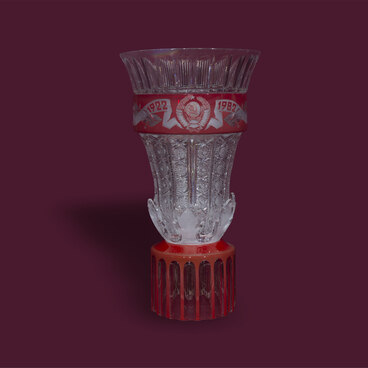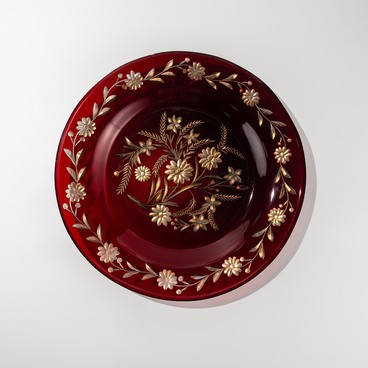Although we might think that glass has always been colorless and transparent, originally, it was colorful. In Russian glass art, the use of color is one of the most distinctive characteristics. Artists strive to interpret the nature of colored glass in household items, decorative objects and compositions, and artworks that are integrated into architecture. As an artistic medium, color depends largely on the method of glass processing.
A plate is one of the oldest vessels for serving food. The “Grapes” plate has a traditional round shape. It was made of colored glass using the blowing technique. The beautiful lilac or violet-purple color is achieved by using neodymium ions in the form of neodymium oxide. When the glass layer is thicker or a higher concentration of the colorant is used, the purple-red shade of the glass resembles alexandrite, a natural gemstone. This is why such glass is sometimes referred to as alexandrite glass.
The alexandrite or two-color effect is the ability of the glass containing a neodymium oxide to change color depending on the light source. Neodymium is a rare-earth metal, making its oxide rather expensive. Most often, the cheaper neodymium concentrate is used in glass production. The most beautiful items make use of several thickness levels where the thinner areas of walls look violet, and the thicker areas look purple-red. The thickness of this plate is determined by the intention not only to demonstrate the play of color but also to use a large cutting pattern. Apart from art, neodymium glass is used in various areas, including optics, measuring instruments, jewelry production, and medical equipment.
The two ripe grape bunches were designed using the “pit” cutting. This round-shaped cutting technique is sometimes referred to as “a lens” or “optical” cutting. The diamond-cut patterns were applied on the back side of the plate. This technique gives the product a festive look and makes it more practical: because this plate is easy to wash.
A plate is one of the oldest vessels for serving food. The “Grapes” plate has a traditional round shape. It was made of colored glass using the blowing technique. The beautiful lilac or violet-purple color is achieved by using neodymium ions in the form of neodymium oxide. When the glass layer is thicker or a higher concentration of the colorant is used, the purple-red shade of the glass resembles alexandrite, a natural gemstone. This is why such glass is sometimes referred to as alexandrite glass.
The alexandrite or two-color effect is the ability of the glass containing a neodymium oxide to change color depending on the light source. Neodymium is a rare-earth metal, making its oxide rather expensive. Most often, the cheaper neodymium concentrate is used in glass production. The most beautiful items make use of several thickness levels where the thinner areas of walls look violet, and the thicker areas look purple-red. The thickness of this plate is determined by the intention not only to demonstrate the play of color but also to use a large cutting pattern. Apart from art, neodymium glass is used in various areas, including optics, measuring instruments, jewelry production, and medical equipment.
The two ripe grape bunches were designed using the “pit” cutting. This round-shaped cutting technique is sometimes referred to as “a lens” or “optical” cutting. The diamond-cut patterns were applied on the back side of the plate. This technique gives the product a festive look and makes it more practical: because this plate is easy to wash.


